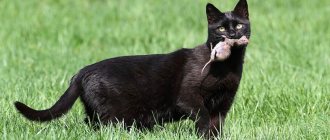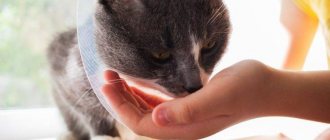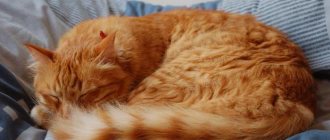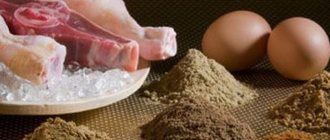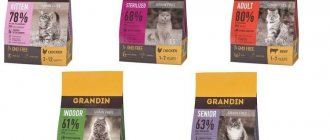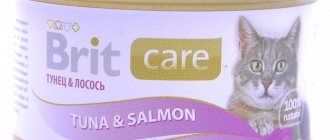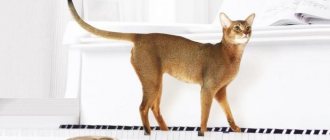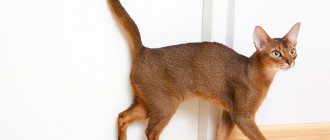What is taurine, its benefits and harm for cats
Every cat and dog breeder knows that the key to a pet’s health is a balanced diet, rich in nutrients and substances valuable to the body. In this article I will talk about one of the important microelements - taurine, and its beneficial properties. I will also describe the signs by which you can recognize a deficiency of the substance in cats, methods of its treatment and prevention.
What is taurine and why do cats need it?
Taurine is a biologically active microelement belonging to the group of sulfoamino acid and vitamin-like substances. For normal life, it must be present in most tissues of the animal, including muscle and heart muscle.
Cats are not naturally designed to produce this valuable substance, so it is important to enrich their diet with foods, feeds or vitamin complexes that contain taurine.
To evaluate the usefulness, it is worth familiarizing yourself with the effect of the amino acid component on the pet’s body.
For a cat to live a normal life, taurine must be present in the heart and muscle mass.
- The biologically active substance promotes the process of calcium entry and exit from cells and ensures normal cardiac activity. If there is a lack of it, the animal develops cardiomyopathy.
- Taurine is a valuable antioxidant that strengthens the body's protective functions. Microelement deficiency reduces immunity.
- The digestive system malfunctions due to a lack of substance. The amino acid takes part in the synthesis of fatty acids in the liver, the breakdown and absorption of fat cells supplied with food.
- Taurine deficiency can cause miscarriages in a pregnant cat or other pathologies, since amino acids are involved in the reproductive system.
- Deficiency leads to retinal degeneration , which can cause the cat to go blind.
Signs of Deficiency
The largest amount of amino acid is required for the muscle tissue of the heart and retina, therefore, if there is a deficiency of the substance in the pet’s body, these organs are the first to suffer.
The breeder should be alert to the following symptoms in the cat:
- drowsiness and lethargy;
- hypothermia (decrease in body temperature below the standard value);
- excessive hair loss;
- destruction of tooth enamel;
- blurred vision;
- dehydration;
- loss of appetite.
Baldness and hair loss are one of the signs of taurine deficiency.
If the problem is not recognized at the initial stage, the consequences can be serious:
- decreased reproductive activity , miscarriages during pregnancy;
- vision loss;
- various congenital pathologies in kittens.
What cat foods contain
All professional cat food includes taurine, so there is no need to worry about enriching your pet’s body with the amino acid.
The most popular brands are:
- Friskies Adult;
- Kitekat;
- Night Hunter;
- Sheba "Pleasure";
- Optimal;
- Royal Canin and others
With this approach, it is important not only to develop a balanced menu, but also to pay great attention to the quality of the products used, as well as their storage conditions.
When left in the refrigerator or cooked for a long time, the lion's share of the active substance evaporates, and the remaining part may not cover the body's needs for taurine. Therefore, it is logical to supplement food with vitamin complexes, including amino acids.
To replenish amino acids in the animal’s body, you need to add the following products to the menu:
- turkey;
- tuna;
- chicken meat;
- beef heart;
- a rabbit;
- liver;
- seafood.
To compensate for the lack of taurine, you can add turkey to your cat’s menu.
Which food has the most meat and which has the most water?
Consumers believe that there is practically no meat in wet food, only water, thickeners, plant components and all kinds of “trimmings”. Is it so? Let's look at indicators such as protein, moisture, fiber, starch, etc. The feed was also studied for the presence of fat and connective tissue. Adipose and connective tissue were found in small quantities.
Protein
Protein content is primarily of interest to animal owners. This is meat protein, not plant protein. Manufacturers are not trying to save money. According to GOST, protein in feed should be at least 26%, in fact in products it is from 30 to 92%. Details are in the product cards.
There are no restrictions on maximum protein content. Critically ill animals may require foods high in fat and protein during recovery and rehabilitation (veterinary diets). But remember that we were researching food for healthy cats. And you need to understand that with an excess of protein and fat, the cat may begin to gain weight, and liver and kidney diseases may occur.
From the reference book “Feeding Dogs and Cats”:
Excess protein for dogs and cats is also harmful, as it can cause toxic phenomena leading to overload of the liver and kidneys with its breakdown products, overstrain of the secretory function of the digestive system, increased putrefactive processes in the intestines, accumulation in the body of nitrogen metabolism products with acid-base shifts balance on the sour side. (Khokhrin S.N. Feeding dogs and cats. Directory. - M.: KolosS, 2006, p. 15).
Chicken or not?
To find out whether it actually contained chicken meat, experts tested samples for DNA from rabbit, cattle, pig, chicken, and turkey.
Chicken DNA was found in all samples. Pig DNA was detected in some foods that stated that they contained pork in addition to chicken.
One food (TM Nature's table "Chicken in Sauce") contains DNA from cattle and pigs, but neither beef nor pork is included in the labeling. Most likely, this is contamination (accidental impurities): it is unlikely that the manufacturer will add more expensive raw materials to poultry products and will not report it.
Cellulose
Many people believe that the more meat, the better. No. Meat in its pure form will not satisfy the needs of the animal. Therefore, the food must contain fiber, which is responsible for digestion. If it is completely absent, the cat’s digestion may be impaired. But according to GOST, fiber should be no more than 3.5%. And this is correct, otherwise the cheap component will displace the valuable meat contents.
Almost all the products studied contained too much fiber - from 5 to 13%. Only Friskies (2.2%) and Schesir (less than 2%, within the error of determination) have the same amount.
If a product is manufactured not according to GOST, but according to specifications, the manufacturer has every right to add as much fiber as it sees fit. But almost all manufacturers were let down by the reliability of the labeling, as we mentioned above: the labeling either indicates that the fiber content is less than 1%, or does not indicate how much at all.
There is practically no fiber in Schesir food, the labeling is reliable (but this food is the only one that has a warning about non-nutrition on the label).
Of course, the amount of fiber can also be justified by the formula of the product - an increased fiber content will help with hair removal, or if the animal is prescribed wet veterinary diets for gastrointestinal diseases (constipation, diarrhea). But in any case, this should be reflected on the label. GOST does not contain information about such diets.
Let us remember that we studied mostly food for healthy animals (19 out of 20 products), which means that there should be no prerequisites for increasing the fiber content.
– Fiber is the name given to polysaccharides contained in plant foods that have a positive effect on the functioning of the gastrointestinal tract. That is, fiber is always necessary. There are several functions of fiber, the main one is stimulation of intestinal function. The chemical composition is not constant and the same for all types of dietary fiber and depends on their source, explains Sergey Kolomiets
. – In some cases, the fiber may be cellulose, and cellulose fibers are not “toilet paper” at all, as you might think, but citrus pulp. By the way, citrus pulp is also used as a thickener for ketchups.
At the same time, all products have normal indicators such as the mass fraction of dry ash and the mass fraction of dry matter. There are relatively few substances in the feed that are not absorbed in transit, but there are enough nutrients.
How much moisture is in wet food?
The moisture in wet food should be at least 60%; it affects the consistency and uniform distribution of substances in the total mass. According to this indicator, the feed is in perfect order, the moisture content varies from 76 to 85%. TM Schesir food contains the most moisture; it is one of the leaders in the rating.
Treatment and prevention of taurine deficiency
To diagnose a substance deficiency, in addition to a thorough examination of the pet by a veterinarian, additional studies are carried out:
- Ultrasound of the heart;
- blood analysis;
- detailed eye examination by a veterinary ophthalmologist.
Diagnosing the problem at an early stage will help prevent the development of dilated cardiomyopathy. If time is lost, the disease is irreversible. But in any case, enriching the body with taurine stops the process of retinal degeneration and is beneficial.
You should carefully study the components included in the composition in order to balance your diet. If everything is clear with ready-made food, then dealing with natural food is more difficult. If a product contains taurine, this does not mean that the required amount of the amino acid enters the body.
When meat is frozen, taurine disappears along with the water.
For example, meat contains a valuable substance, but when frozen, it disappears from the product along with water. Therefore, any diet should be supplemented with a dietary supplement containing taurine. At the same time, the pet is not in danger of oversaturation, because the excess is excreted naturally (with urine) without causing harm.
Complete and balanced feed.
Canagan food for cats and dogs - biologically appropriate nutrition New food from the English manufacturer Canagan
We feed our pets either natural food or commercial food. In both cases, the principle of approach to the formation of a diet is the same: it must be complete and balanced. In other words, a pet should receive a certain amount of proteins, fats, carbohydrates, microelements and vitamins every day. The lack of one or another component will certainly affect (perhaps not immediately, but over time) on his well-being, physical fitness and, ultimately, health.
Taurine is an amino acid found in animal proteins. It is key to normal vision, digestion, heart function, pregnancy and fetal development, and a healthy immune system.
The name goes back to Lat. taurus (ox), since it was first obtained from ox bile by German scientists Friedrich Tiedemann and Leopold Gmelin in 1827. Humans and most mammals are able to produce sufficient amounts of taurine from other amino acids.
However, as it turns out, cats cannot produce it, so taurine is classified as an essential amino acid for cats.
Holistic PureLuxe - the food you've been looking for Review of the American holistic food PureLuxe
Fortunately for cats, taurine can be easily obtained from the diet, as long as it contains sufficient animal protein. Unfortunately, cats' bodies cannot store taurine, so they must consume it regularly.
When, at the end of the last century, Western scientists proved that it is animal, and not plant protein, that plays a dominant role in the proper nutrition of domestic animals (primarily cats), the presence of taurine in them became a mandatory requirement for manufacturers of commercial feed.
Sometimes cat food manufacturers claim that taurine must be added separately not because there is little meat in the food, but because this important amino acid is partially destroyed during the production process of the food. This observation is true for canned food, where, due to different production technologies, twice as much taurine must be added to ensure that cats have enough of it in the final product.
The recommended level of taurine is 1000 mg per kg dry matter in dry food and 2000 mg per kg dry matter in wet food. These are 0.1% and 0.2% respectively. But these are approximately the required standards. It all depends on the composition of the ingredients in the food (the advantage and amount of plant or animal proteins in it and, of course, which one).
What is taurine
Until cats were spoiled by humans and sat on pasture, they were always provided with taurine, thanks to mice whose brains are oversaturated with this essential amino acid.
Health problems began as soon as the mustachios lost their hunting skills and switched to refined food . It turned out that the cat’s body (unlike the dog’s, in particular) is not able to synthesize taurine from cysteine and methionine supplied with protein foods.
Taurine became known in the 30s of the last century, from the moment of discovery of this sulfur-containing amino acid in bovine bile, which owes its name to the Latin word taurus - “bull”.
Let us remember that any amino acid is a building material for proteins and a source of energy/performance. Taurine, for example, is responsible for visual acuity, childbirth, cardiovascular and digestive systems, and also supports the body's defenses.
The latter, as is known, is capable of producing part of the amino acids it needs on its own, the rest must come from outside, along with food.
This is interesting! Different animal species have their own amino acids, which are commonly called essential.
For cats, taurine turned out to be such an amino acid, both due to its amazing capabilities and because of its stubborn “reluctance” to be produced inside the body.
Causes of food allergies
Food allergies can be caused by various reasons. For example, in the area where the animal lives, the environmental situation is poor. Parasites or digestive problems provoke a reaction to one of the components of the feed. A long-term illness due to which the immune system has become weakened will lead to the same consequence.
One of the most common reasons is cheap food that contains too many flavor enhancers. However, an individual illness can occur in an animal due to high-quality, balanced food. There is no guarantee that pets will not develop health problems from this or that industrial food. It all depends on individual characteristics.
The components of the food may not be suitable for your pet. Among which is soy. Chemical additives in the form of dyes, flavor enhancers, flavorings. Gluten or wheat gluten; meat components. The sulfur-containing amino acid taurine.
Taurine is added to many feeds. This amino acid stimulates energy processes. Cats consuming food with taurine become more active and cheerful. But it is this additive that can become an allergen.
Why does a domestic cat need taurine?
There is a hundred times more taurine in the retina of a cat's eye than in its blood. It is logical that the lack of amino acid affects, first of all, vision: the retina begins to degenerate, and the cat quickly and irreversibly goes blind.
Taurine facilitates the work of the heart muscle by regulating the movement (out of the cell and in) of calcium ions.
It is estimated that 50% of the free amino acids in a cat's heart are taurine . It is not surprising that its deficiency immediately affects the cardiovascular system, leading to such a common illness as dilated cardiomyopathy.
Taurine calms the nervous system, controls the process of blood clotting, forms active immunity, is responsible for the health of the reproductive system and is classified as an effective antioxidant.
Without taurine, a cat cannot synthesize bile salts, which help digest fats in the small intestine.
Why do cats need taurine?
Feed with tuarine - is it necessary or not?
When buying food for your pet at a pet store (more about the composition of cat food), you probably noticed that some packages have a note that the food contains taurine. This name means nothing to most of us.
So when the conversation turns to choosing a food with or without taurine, we brush it off, saying it doesn't matter. Another useless supplement. In fact, there is a meaning. After all, taurine is vital for cats. And today we will tell you why and why. We will also explain what the lack of taurine in your pet’s diet leads to.
What role does taurine play in the cat's diet?
In addition to being essential for your cat to see well, be active and healthy, taurine is also essential for the digestion of fats in the small intestine. Let us remember that what distinguishes cats from other animals is their inability to use other acids. At the same time, the need for taurine itself, unfortunately, cannot be fully met through the synthesis of sulfur-containing acids alone, which enter the cat’s body with food. This explains the need to feed the cat food that contains animal protein. After all,
taurine cannot be contained in components of plant origin.
What does a lack of taurine cause in a cat's diet?
General condition of the body
With a lack of taurine, nerve tissue suffers. After all, the substance has a protective property at the cellular level. Without it, problems with immunity, blood clotting, or increased incidence of respiratory system diseases may occur.
At the same time, a very important point
The lack of taurine for each animal has its own characteristic manifestations. Some suffer from heart muscle damage, while others lose their vision.
How to compensate for taurine deficiency
How much taurine should be in food?
Today, many manufacturers, knowing about the properties of taurine and its benefits for the cat’s body, speculate by indicating on the packaging of the food that it contains taurine. However, not every such food actually contains the required concentration of the substance. Thus, experts even outlined the recommended minimum level.
Its indicators are 1000 mg of taurine per 1 kilogram of dry food, or 0.1%. If we are talking about canned food and soft food, then it should contain 2 times more - 0.2%. Food with less taurine content is not worth buying. They will not help compensate for taurine deficiency.
And finally, an interesting point.
It is not customary to add taurine to dog food. They don't need it.
This is another argument why cats should not be fed canned food and dry dog food.
Video about vitamins with taurine for cats
Today we talked about taurine and its role for the cat’s body. Do you buy food with taurine for your pet? What is the concentration of the substance in them? Share your experiences, choices and stories with us.
We are waiting for your feedback and comments, join our VKontakte group!
Symptoms of Taurine Deficiency
They do not appear immediately, but usually after months and even years, depending on the age of the animal.
The following signs will tell you about the onset of pathological changes in the retina (atrophy):
- the cat bumps into obstacles (corners);
- cannot calculate distance when jumping;
- became overly fearful.
Loss of appetite, apathy and difficulty breathing will indicate that the heart muscle suffers due to the lack of taurine. Untreated dilated cardiomyopathy leads to heart failure and often death of the cat.
Poor coat and teeth, digestive disorders, low resistance to infections are also indicators of the lack of taurine in the body.
Amino acid deficiency also affects the reproductive system, interfering with fertilization (ovulation is often impossible) or preventing the normal course of pregnancy (miscarriages, congenital deformities). If offspring are nevertheless born, the kittens grow poorly and have hidden pathologies.
Sulfur amino acid deficiency is most often observed in cats that are starving or those that eat dog food and improperly prepared natural foods.
Signs of taurine deficiency
The greatest need for taurine is in the heart muscle and retina. An acute shortage of essential amino acids in an animal’s diet provokes, first of all, disturbances in the functioning of the heart and eyes. Long-term taurine deficiency leads to changes in the retina, including complete blindness. The immune and nervous systems, as well as the reproductive function, suffer from a lack of nutrients.
A dangerous consequence of prolonged insufficient supply of the necessary substance to the body is dilated cardiomyopathy. Pathological changes in the myocardium provoke problems with blood circulation, resulting in oxygen starvation.
Signs of taurine deficiency in a cat’s body include:
If you contact a veterinarian in a timely manner and determine the factors that provoked the symptoms, the prognosis is favorable.
The animal's diet is changed and useful supplements with taurine are included. Ignoring signs of taurine deficiency can lead to serious complications, including the death of the cat. It is worth noting that the symptoms of amino acid deficiency appear gradually, over six months, and in some cases, several years.
A lack of taurine poses a health hazard to the future mother cat and her offspring. Often, against the background of deficiency, offspring are born non-viable, anomalies in the development of babies, slow development and low body weight are noted. Taurine deficiency causes the cat’s inability to bear kittens normally, and miscarriages occur.
If you notice your pet has vision problems, damaged tooth enamel, or hair loss, you should not hesitate to visit the veterinary clinic. The doctor will conduct a series of laboratory tests and determine the causes of the disorders. At home, it is not possible to determine a lack or excess of taurine. To confirm a preliminary diagnosis of taurine deficiency, the pet will undergo a blood draw for a general clinical examination, biochemical analysis and specific tests to determine the level of the amino acid in the body. A diagnosed taurine deficiency serves as a reason for conducting ultrasound diagnostics of the heart area, which will allow timely detection of problems in the myocardium, or to exclude their presence.
Treatment of taurine deficiency, prevention
Nutritional supplements have come to the aid of worried cat owners . They have been proven to slow down/stop retinal atrophy, and also cope with dilated cardiomyopathy (especially at its onset), and generally improve the cat's well-being and appearance.
Taurine Supplements
They are safe and very rarely cause side effects, such as allergies or stomach upset. Excess taurine that the body does not absorb is removed from it in the urine. So, vitamins with taurine:
- Beaphar Kitty's Taurine + Biotin (cheese flavor). The package contains 180 vitamins, each of which, along with taurine, contains a set of essential microelements;
- Gimpet – recommended for cats of all breeds. The amino acid is also supplemented with a complex of daily microelements;
- Omega Neo - here taurine and other amino acids are isolated from squid liver. Daily dose – 3-6 tablets, taken year-round;
- Petvital Vitamin-Gel is a vitamin gel with taurine and other active ingredients that prevent stone deposition. The gel is also prescribed to neutralize the negative effects of low-quality industrial feed;
- Doctor ZOO for cats Biotin + Taurine – accelerates metabolism, maintaining the balance of taurine, biotin and trace elements.
Secrets of Taurine
Veterinarians at the University of California have experimentally determined which foods contain the most taurine (more on that later) and how to preserve it during cooking.
The researchers concluded that cooking errors directly affect the concentration of a sulfur-containing amino acid, which can quickly dissolve in water.
What foods contain taurine?
It should be remembered that almost all high-end factory products contain taurine, even if the manufacturer does not indicate this on the packaging.
Dry food
It is safe to say that this amino acid is included in such cat foods as:
- Acana Regionals Pacifica Cat & Kitten – grain-free food for cats and kittens of all breeds/sizes;
- Applaws Grain Free Adult Cat Chicken – grain-free food with chicken for adult cats;
- Grandorf Kitten Lamb & Rice – low-grain food with lamb and rice (holistic class). Designed for kittens;
- GO! Fit + Free Grain Free Chicken, Turkey, Duck Cat Recipe – grain-free food with chicken, duck, turkey and salmon (for kittens/cats);
- Wildcat Etosha - dry food "Wildcat Etosha".
Important! Optimal taurine content: in dry granules - 1000 mg per kg (0.1%), in wet food - 2000 mg per kg (0.2%).
Natural food
Scientists from the University of California looked not only at which foods contain the most taurine.
But we also compared its quantitative indicators in samples obtained in different ways:
- at the place of slaughter of animals;
- from shops and supermarkets;
- from farms.
Record doses of the amino acid were found in fresh meat that was not contaminated with bacteria and had not been stored for a long time.
This is interesting! It also turned out that the concentration of taurine is influenced by the breed of livestock, as well as how it is kept and what it is fed.
So, a list of products with essential amino acids for cats:
- raw seafood is a storehouse of taurine;
- poultry (especially turkeys and chickens) – high in taurine;
- so-called red meat - taurine is concentrated in internal organs, muscle tissue, and the brain. Distributed extremely unevenly in the liver;
- eggs - the amino acid is present in sufficient volume;
- dairy products (milk, cheese, yogurt, ice cream) – the proportion of taurine is insignificant.
The Americans also tried to find taurine in plants, for which they tested vegetables (including legumes), fruits, cereals, seeds and nuts. Conclusion - sulfonic acid was not found. But scientists were pleased with yeast and seaweed, where taurine was still found.
Where is taurine found?
Most taurine is found in meat, liver, heart, and kidneys. Found in small quantities in dairy products and eggs. Plant products practically do not contain this substance. The highest concentrations are in raw meat and fish. During heat treatment, the taurine contained in them is destroyed. The leaders in amino acid levels are turkey meat and tuna fish.
| Product | Amino acid level (mg/100g) | % of daily norm |
| Dark meat turkey | 360 | 77 |
| Tuna (raw fish) | 280 | 71 |
| Chicken (dark meat) | 170 | 43 |
| Raw red fish | 130 | 33 |
| Chicken heart and liver | 117 | 30 |
Taurine in industrially produced cat food is guaranteed to be in the “premium” and “super premium” classes. In industrial economy class feeds, the additive is minimal or absent.
If the animal eats vegetarian food or the composition contains cereals in the first place, then the cat does not receive acid in the required volume. She needs supplements.
The study determined the minimum level of taurine in cat food:
- For dry granules - 1 -1.2 g per 1 kg of feed (0.1-0.12%).
- For canned food - no less than 1.7 g, and better - 2-2.5 g per 1 kg (0.2-0.25%).
It has been scientifically proven that even a dose of 10 g of taurine per kilogram of feed is safe for animals.
Beneficial properties of taurine
Taurine for cats has many beneficial properties. After identifying its deficiency, the doctor prescribes a drug that contains amino acids. It is recommended to buy Astrapharm products. This is a company that produces high-quality pet products and medicines for animals.
Taurine-based drug
The drug may contain not only taurine, but also other useful amino acids, for example, biotin. You can buy the medicine in retail pharmacies or online sites. The benefits of essential amino acids include the treatment of the following diseases:
- arrhythmia, tachycardia, bradycardia, conduction disturbances;
- poisoning with cardiac glycosides;
- prevention of complications from diabetes mellitus types 1 and 2, as a result of which retinopathy is formed, that is, conglomerates of glucose and cholesterol clog microcirculation vessels (vision deteriorates, complete blindness may develop);
- therapy of cardiovascular failure in combination with the use of other drugs;
- disruption of retinal nutrition through blood vessels;
- malnutrition of the cornea;
- clouding of the lens due to increasing age, diabetes, mechanical damage;
- mechanical damage to the cornea, the amino acid helps accelerate metabolism, due to which damaged tissue is regenerated to an increased extent.
For your information! The substance is usually formed in the body in the form of cysteine. It helps increase energy in cells. This leads to increased regeneration of damaged tissues and renewal of cellular composition.
More often, the drug is used for dystrophic disorders, due to which pathologies of internal organs develop. When the amino acid penetrates the cells, the quality of the membrane improves and it becomes stable. Energy and metabolic processes are normalized.
The advantage of the product is that it has a small number of side effects and contraindications. It is not recommended for use in case of individual intolerance. When taking it, in rare cases, allergic reactions occur on the skin and mucous membranes. But few such cases have been recorded.
Causes of nutritional allergies
Food allergies in cats to food can be of two types - immediate or delayed. An immediate type of allergic-type nutritional reaction occurs abruptly, 3-5 hours after foreign particles enter the body.
The most common cases of immediate allergic reaction to dry food components have been recorded. This is due to their low moisture content and higher concentration of dry matter.
A delayed-type allergy occurs to wet food, appearing after 2-3 days, and in some cases even after a month. Throughout this period, the immune system recognizes pathological particles, trying to cope with them.
Heredity plays an important role in the development of food allergies in dogs and cats. Thus, pets with obviously low immunity, inherited, are more likely to develop allergies than their relatives.
There are many reasons for the development of nutritional allergies. Thus, a specific response of the body to a stimulus may occur due to an unfavorable environmental situation in the area where the pet lives.
Allergies can be triggered by parasitic diseases, as well as illnesses associated with dysfunction of the digestive system.
One of the most common causes of allergic reactions is feeding an animal with cheap types of food. They are enriched with various flavorings and taste enhancers. Chemical components can be recognized by the animal’s body as foreign and affect the pet’s health.
There are also a number of components of natural origin that influence the occurrence of food allergies. Among them are:
- soy;
- gluten;
- fatty meats;
- amino acid taurine.
A cat's allergy to food can develop against the background of hypovitaminosis, helminthic diseases, fungal and infectious diseases. The development of an allergic reaction in kittens most often occurs to lactose and proteins contained in milk. Adult animals suffer from plant and animal proteins.
You should also distinguish between food allergies and food intolerances. Allergies of the nutritional type provoke the development of characteristic symptoms - itching, inflammatory processes on the skin, hair loss, lacrimation, while food intolerance causes the development of more dangerous, and in some cases, life-threatening symptoms (indigestion, diarrhea, gastric eruption). content).
Consequences of taurine deficiency
The doctor may suspect that there is not enough taurine in the cat’s body due to disturbances that appear in the body. More often, the main blow falls on the digestive tract, organs of vision, teeth and gums, skin and fur.
Oral examination
Lack of appetite
The cat's appetite sharply decreases. He may refuse food for several days, then eat it in small quantities. Gradually he completely refuses to eat. This leads to additional negative consequences:
- weight loss;
- hypovitaminosis or vitamin deficiency, which leads to brittle bones, hair loss, hearing and vision impairment, and deterioration of cognitive functions;
- fatigue, weakness, drowsiness, lack of any physical activity.
Taurine Supplements
In order not to harm the cat’s health with serious medications, they give vitamins based on amino acids. Owners are interested in how much taurine a cat needs per day. They will find out the answer to the question from the veterinarian, since different individuals require different volumes.
There are the most common medications that will make your cat feel better:
- Beaphar Kittys Taurine - the product has the taste of cheese, is available in large packages, contains a daily set of all necessary microelements;
- Omega Neo is a medicine based on vitamins contained in squid liver, the product is used daily;
- Gimpet - in addition to amino acids, the composition also contains other microelements; vitamins can be given to a cat up to 4 times a day;
- Doctor zoo is a food supplement that improves the metabolic process, normalizes the composition of biotin and taurine;
- Petvital Vitamin is a gel based on amino acids and other active substances, which eliminates the possibility of developing urolithiasis and increases the life expectancy of the animal.
Taurine-based drug
Note! Before giving medicine to your pet, you should consult with your veterinarian to find out why you should give vitamins.
You should not use them yourself.
Dry and wet food containing taurine
Many owners do not know about taurine in cat food, what it is. In fact, it is an essential amino acid, with the help of which tissues are restored and cellular balance is renewed.
There are amino acid based cat foods. For example, “Proplan” with taurine. It contains a large dose of the substance, so it is able to completely replace the missing microelement.
The substance is also present in other feeds:
Important! They contain an equal amount of the substance, so the dosage is selected individually for each pet after a visit to the doctor. If the breeder independently uses food that the cat does not need, it will be harmful.
